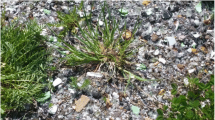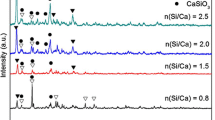Abstract
Experiments on vitrifying a surrogate for SB2 pulp from the Savannah River facility (USA) in a cold crucible with inner diameter 418 mm in a commercial facility for vitrifying medium-level wastes at the Moscow Scientific and Industrial Association Radon are performed. Borosilicate glass materials, containing 50 mass % oxides of the wastes, including a magnetitic spinel phase in amounts not exceeding 15 vol. %, are obtained. The maximum mass average velocity of the slurry load and the melt output reach 40 and 16 kg/h, respectively. This corresponds to maximum specific vitrified wastes production capacity 2830 kg/(m2·day). The specific energy consumption for obtaining the glass product is about 10 kW·h/kg, which is approximately half the level for reprocessing slurries in crucibles with half the diameter. The chemical stability of the glass materials is 10–50 times higher than that of the materials made from glasses recommended by the US Environmental Protection Agency.
Similar content being viewed by others
References
F. A. Lifanov, I. A. Sobolev, S. A. Dmitriev, et al., “Vitrification of low and intermediate level waste: technology and glass performance,” in: Proceedings of the International Conference on Waste Management’04, Tucson, USA (2004), CD-ROM, ID WM-4010.
A. P. Kobelev, S. V. Stefanovsky, O. A. Knyasev, et al., “Induction heated cold crucible melter testing with troublesome high level waste components,” in: Proceedings of the 107th American Ceramic Society Meeting, Baltimore, April 10–13, 2005, pp. 159–169.
A. P. Kobelev, S. V. Stefanovsky, O. A. Knyasev, et al., “Cold crucible vitrification of defense waste surrogate and vitrification product characterization,” Mat. Res. Soc. Symp. Proc., 932, 353–360 (2006).
A. P. Kobelev, S. V. Stefanovsky, O. A. Knyasev, et al., “Results of a 50% waste loading vitrification test using the cold crucible melter for Savannah River site,” in: Proceedings of the International Conference on Waste Management’06, Tucson, USA (2006), CD-ROM, ID 6127.
A. P. Kobelev, S. V. Stefanovskii, V. N. Zakharenko, et al., “Vitrification of a surrogate for high-level wastes from the Savannah River plant (USA) on a bench facility,” At. Énerg., 102, No. 4, 225–232 (2007).
S. Marra, R. O’Driscoll, T. Fellinger, et al., “DWPF vitrification-transition to the second batch of HLW radioactive sludge,” in: Proceedings of the International Conference on Waste Management’99, Tucson, USA (1999), CD-ROM, ID 48-5.
Standard Test Methods for Determining Chemical Durability of Nuclear, Hazardous, and Mixed Waste Glasses: The Product Consistency Test (PCT), ASTM V1285-97 (1997).
J. Harbour, Summary of Results for Macrobatch 3 Variability Study, Rep. WSRC-TR-2000-00351 (2000).
C. Herman, Summary of Results for Expanded Macrobatch 3 Variability Study, Rep. WSRC-TR-2001-0051 (2001).
Author information
Authors and Affiliations
Additional information
__________
Translated from Atomnaya Énergiya, Vol. 102, No. 5, pp. 296–299, May, 2007.
Rights and permissions
About this article
Cite this article
Kobelev, A.P., Stefanovskii, S.V., Zakharenko, V.N. et al. Vitrification of a surrogate for high-level wastes from the Savannah River facility (USA) in a commercial cold-crucible facility. At Energy 102, 369–374 (2007). https://doi.org/10.1007/s10512-007-0058-3
Received:
Issue Date:
DOI: https://doi.org/10.1007/s10512-007-0058-3




